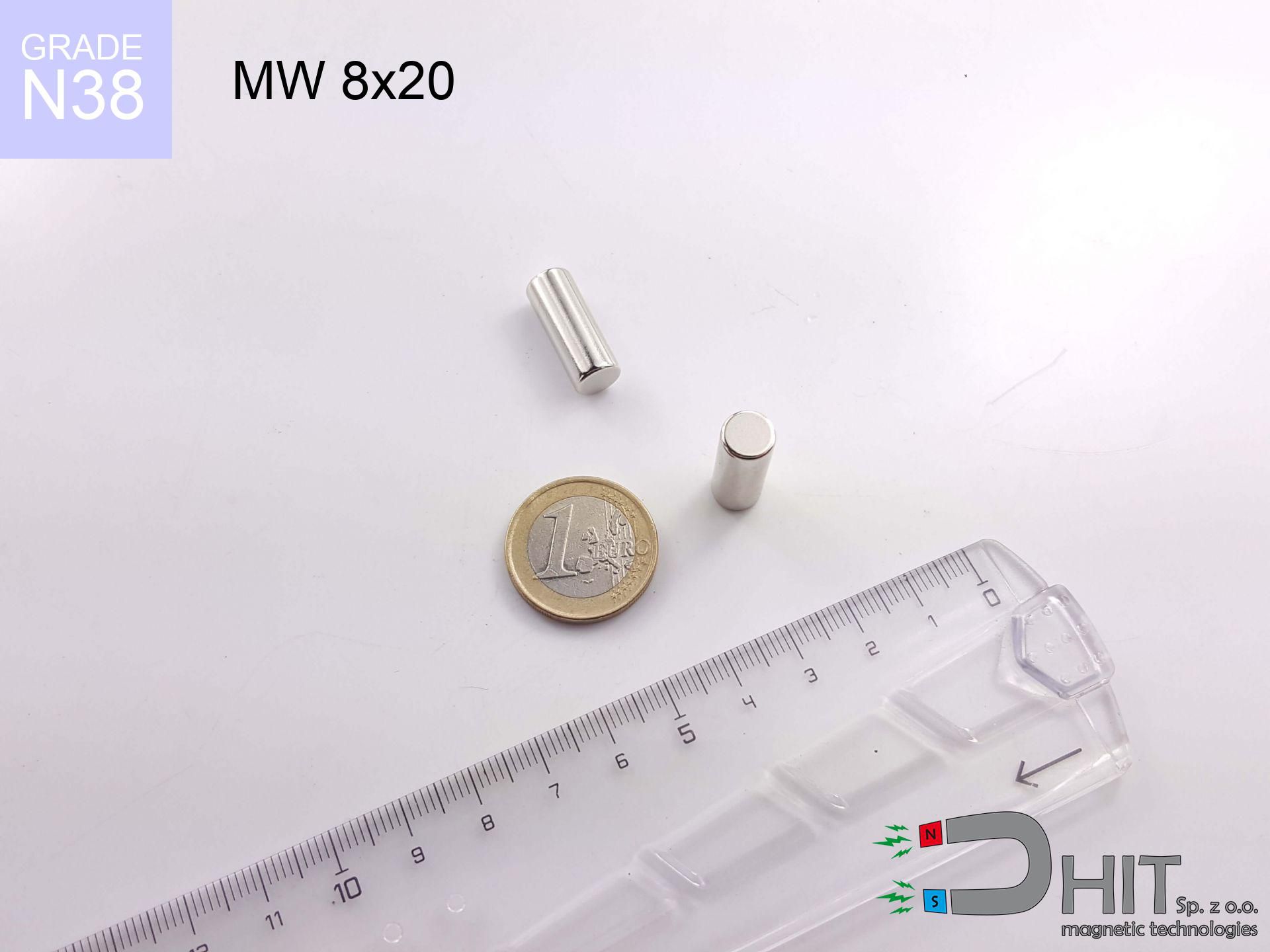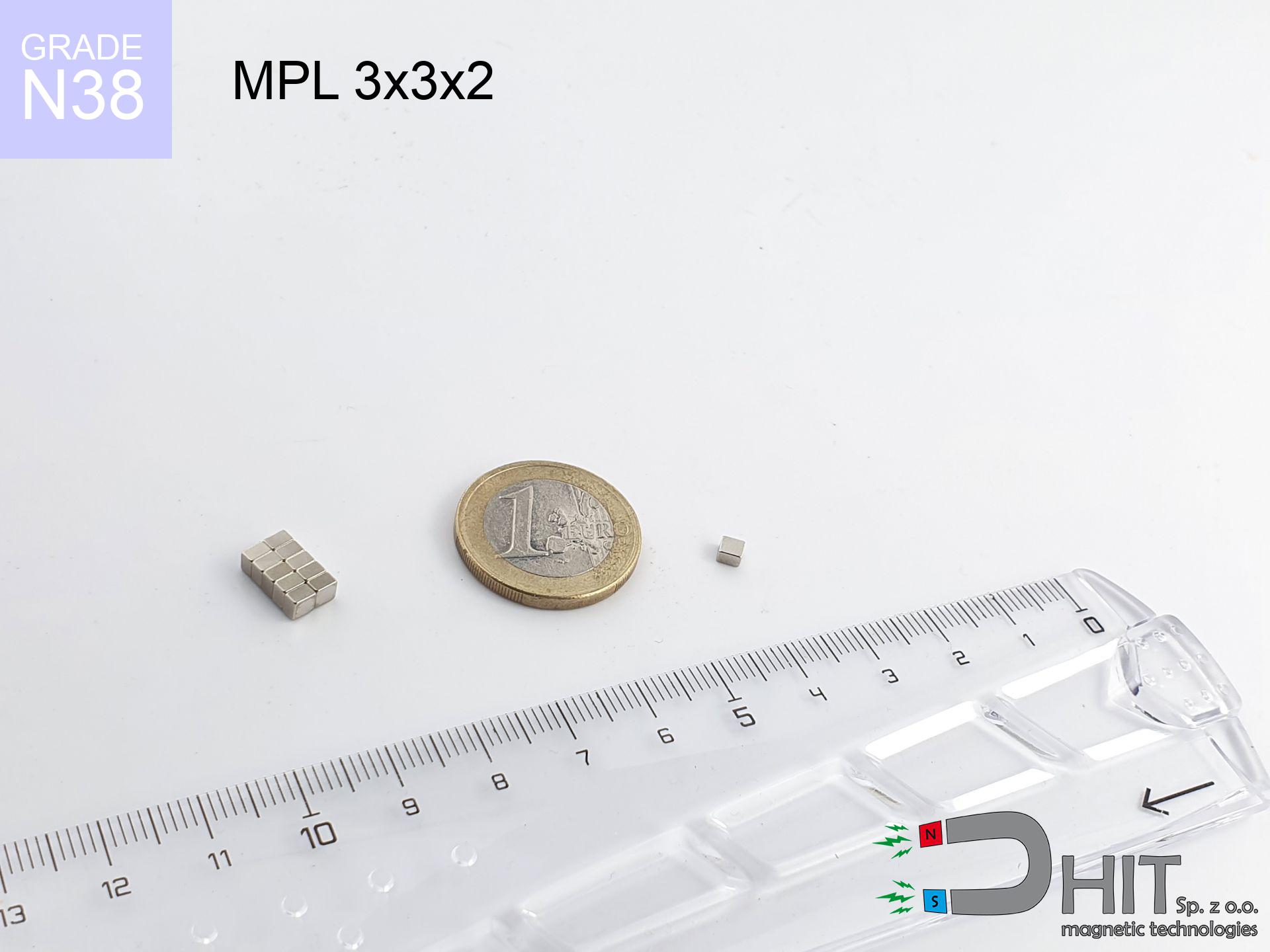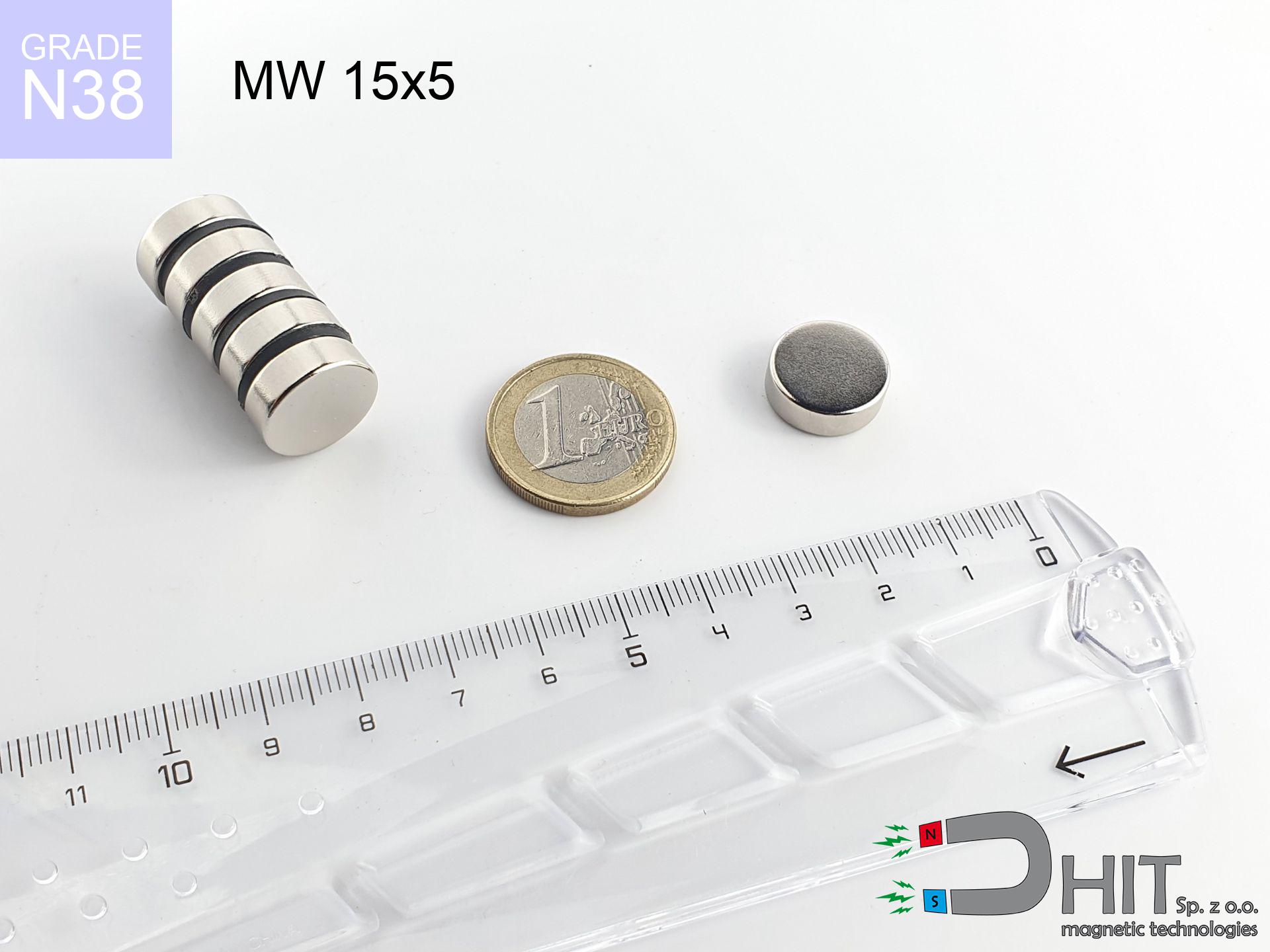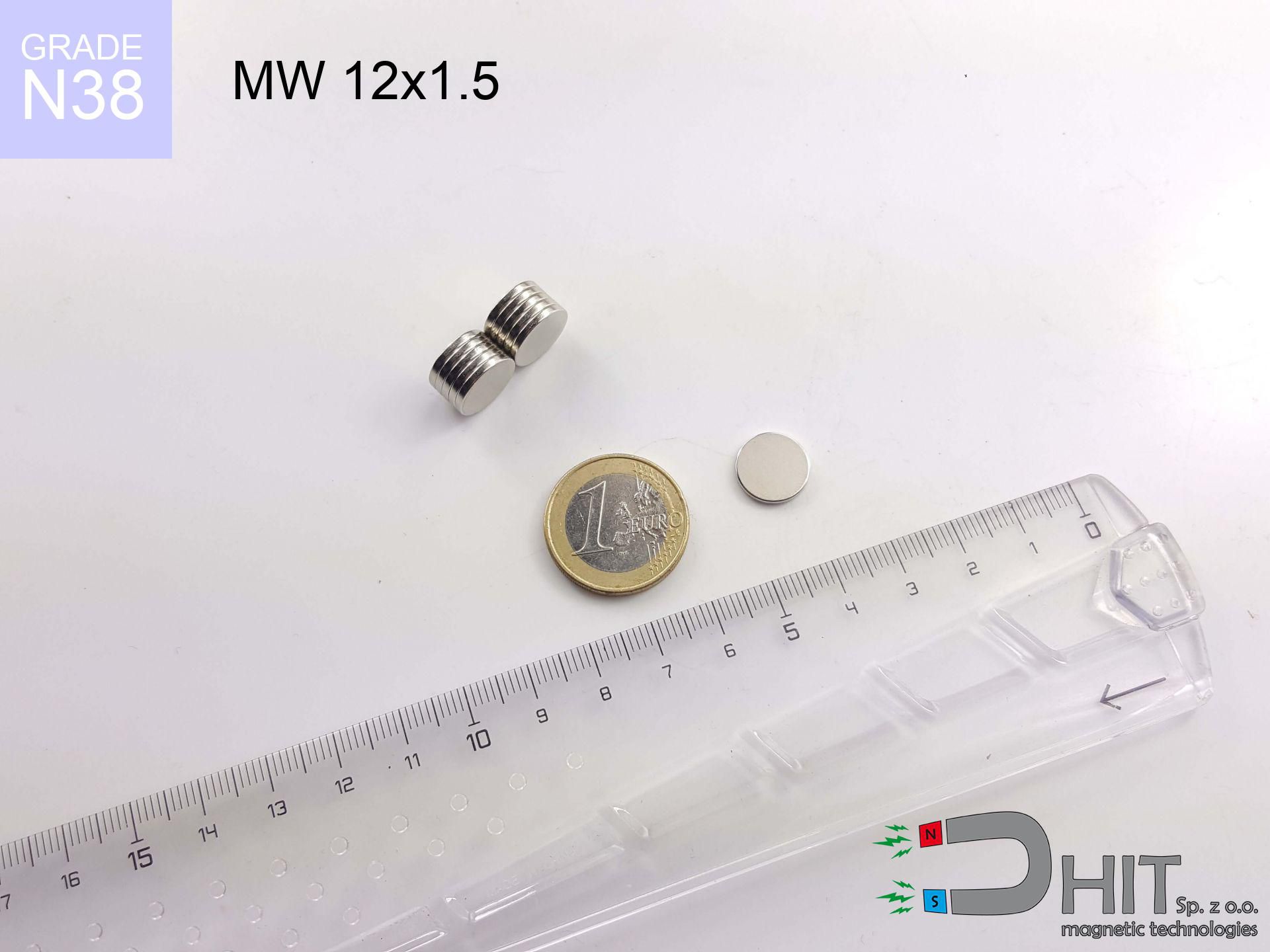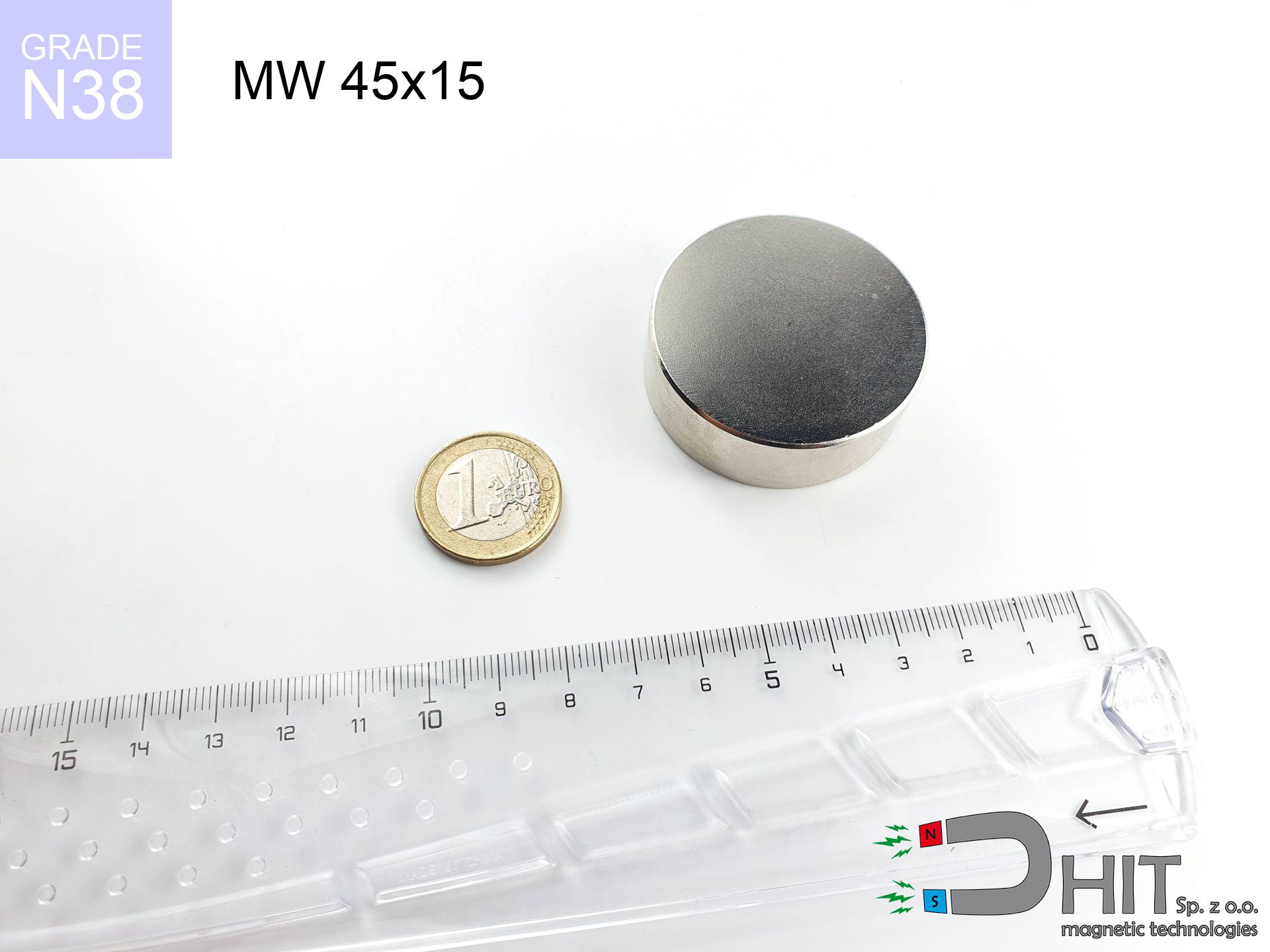MW 8x20 / N38 - cylindrical magnet
cylindrical magnet
Catalog no 010475
GTIN: 5906301811138
Diameter Ø
8 mm [±0,1 mm]
Height
20 mm [±0,1 mm]
Weight
7.54 g
Magnetization Direction
→ diametrical
Load capacity
1.30 kg / 12.71 N
Magnetic Induction
607.01 mT / 6070 Gs
Coating
[NiCuNi] Nickel
4.60 ZŁ with VAT / pcs + price for transport
3.74 ZŁ net + 23% VAT / pcs
bulk discounts:
Need more?Want to negotiate?
Call us
+48 888 99 98 98
if you prefer drop us a message by means of
our online form
our website.
Force and appearance of a neodymium magnet can be reviewed with our
online calculation tool.
Orders placed before 14:00 will be shipped the same business day.
MW 8x20 / N38 - cylindrical magnet
Specification / characteristics MW 8x20 / N38 - cylindrical magnet
| properties | values |
|---|---|
| Cat. no. | 010475 |
| GTIN | 5906301811138 |
| Production/Distribution | Dhit sp. z o.o. |
| Country of origin | Poland / China / Germany |
| Customs code | 85059029 |
| Diameter Ø | 8 mm [±0,1 mm] |
| Height | 20 mm [±0,1 mm] |
| Weight | 7.54 g |
| Magnetization Direction | → diametrical |
| Load capacity ~ ? | 1.30 kg / 12.71 N |
| Magnetic Induction ~ ? | 607.01 mT / 6070 Gs |
| Coating | [NiCuNi] Nickel |
| Manufacturing Tolerance | ±0.1 mm |
Magnetic properties of material N38
| properties | values | units |
|---|---|---|
| remenance Br [Min. - Max.] ? | 12.2-12.6 | kGs |
| remenance Br [Min. - Max.] ? | 1220-1260 | T |
| coercivity bHc ? | 10.8-11.5 | kOe |
| coercivity bHc ? | 860-915 | kA/m |
| actual internal force iHc | ≥ 12 | kOe |
| actual internal force iHc | ≥ 955 | kA/m |
| energy density [Min. - Max.] ? | 36-38 | BH max MGOe |
| energy density [Min. - Max.] ? | 287-303 | BH max KJ/m |
| max. temperature ? | ≤ 80 | °C |
Physical properties of sintered neodymium magnets Nd2Fe14B at 20°C
| properties | values | units |
|---|---|---|
| Vickers hardness | ≥550 | Hv |
| Density | ≥7.4 | g/cm3 |
| Curie Temperature TC | 312 - 380 | °C |
| Curie Temperature TF | 593 - 716 | °F |
| Specific resistance | 150 | μΩ⋅Cm |
| Bending strength | 250 | Mpa |
| Compressive strength | 1000~1100 | Mpa |
| Thermal expansion parallel (∥) to orientation (M) | (3-4) x 106 | °C-1 |
| Thermal expansion perpendicular (⊥) to orientation (M) | -(1-3) x 10-6 | °C-1 |
| Young's modulus | 1.7 x 104 | kg/mm² |
Technical analysis of the product - technical parameters
Presented values represent the result of a engineering simulation. Values were calculated on models for the material NdFeB. Operational parameters might slightly differ from theoretical values. Use these data as a preliminary roadmap when designing systems.
MW 8x20 / N38
| Distance (mm) | Induction (Gauss) / mT | Pull Force (kg) | Risk Status |
|---|---|---|---|
| 0 mm |
6064 Gs
606.4 mT
|
1.30 kg / 1300.0 g
12.8 N
|
weak grip |
| 1 mm |
4587 Gs
458.7 mT
|
0.74 kg / 743.7 g
7.3 N
|
weak grip |
| 2 mm |
3327 Gs
332.7 mT
|
0.39 kg / 391.4 g
3.8 N
|
weak grip |
| 3 mm |
2388 Gs
238.8 mT
|
0.20 kg / 201.6 g
2.0 N
|
weak grip |
| 5 mm |
1281 Gs
128.1 mT
|
0.06 kg / 58.0 g
0.6 N
|
weak grip |
| 10 mm |
389 Gs
38.9 mT
|
0.01 kg / 5.4 g
0.1 N
|
weak grip |
| 15 mm |
169 Gs
16.9 mT
|
0.00 kg / 1.0 g
0.0 N
|
weak grip |
| 20 mm |
90 Gs
9.0 mT
|
0.00 kg / 0.3 g
0.0 N
|
weak grip |
| 30 mm |
35 Gs
3.5 mT
|
0.00 kg / 0.0 g
0.0 N
|
weak grip |
| 50 mm |
10 Gs
1.0 mT
|
0.00 kg / 0.0 g
0.0 N
|
weak grip |
MW 8x20 / N38
| Distance (mm) | Friction coefficient | Pull Force (kg) |
|---|---|---|
| 0 mm | Stal (~0.2) |
0.26 kg / 260.0 g
2.6 N
|
| 1 mm | Stal (~0.2) |
0.15 kg / 148.0 g
1.5 N
|
| 2 mm | Stal (~0.2) |
0.08 kg / 78.0 g
0.8 N
|
| 3 mm | Stal (~0.2) |
0.04 kg / 40.0 g
0.4 N
|
| 5 mm | Stal (~0.2) |
0.01 kg / 12.0 g
0.1 N
|
| 10 mm | Stal (~0.2) |
0.00 kg / 2.0 g
0.0 N
|
| 15 mm | Stal (~0.2) |
0.00 kg / 0.0 g
0.0 N
|
| 20 mm | Stal (~0.2) |
0.00 kg / 0.0 g
0.0 N
|
| 30 mm | Stal (~0.2) |
0.00 kg / 0.0 g
0.0 N
|
| 50 mm | Stal (~0.2) |
0.00 kg / 0.0 g
0.0 N
|
MW 8x20 / N38
| Surface type | Friction coefficient / % Mocy | Max load (kg) |
|---|---|---|
| Raw steel |
µ = 0.3
30% Nominalnej Siły
|
0.39 kg / 390.0 g
3.8 N
|
| Painted steel (standard) |
µ = 0.2
20% Nominalnej Siły
|
0.26 kg / 260.0 g
2.6 N
|
| Oily/slippery steel |
µ = 0.1
10% Nominalnej Siły
|
0.13 kg / 130.0 g
1.3 N
|
| Magnet with anti-slip rubber |
µ = 0.5
50% Nominalnej Siły
|
0.65 kg / 650.0 g
6.4 N
|
MW 8x20 / N38
| Steel thickness (mm) | % power | Real pull force (kg) |
|---|---|---|
| 0.5 mm |
|
0.13 kg / 130.0 g
1.3 N
|
| 1 mm |
|
0.33 kg / 325.0 g
3.2 N
|
| 2 mm |
|
0.65 kg / 650.0 g
6.4 N
|
| 5 mm |
|
1.30 kg / 1300.0 g
12.8 N
|
| 10 mm |
|
1.30 kg / 1300.0 g
12.8 N
|
MW 8x20 / N38
| Ambient temp. (°C) | Power loss | Remaining pull | Status |
|---|---|---|---|
| 20 °C | 0.0% |
1.30 kg / 1300.0 g
12.8 N
|
OK |
| 40 °C | -2.2% |
1.27 kg / 1271.4 g
12.5 N
|
OK |
| 60 °C | -4.4% |
1.24 kg / 1242.8 g
12.2 N
|
OK |
| 80 °C | -6.6% |
1.21 kg / 1214.2 g
11.9 N
|
|
| 100 °C | -28.8% |
0.93 kg / 925.6 g
9.1 N
|
MW 8x20 / N38
| Gap (mm) | Attraction (kg) (N-S) | Repulsion (kg) (N-N) |
|---|---|---|
| 0 mm |
1.31 kg / 1307 g
12.8 N
12 159 Gs
|
N/A |
| 1 mm |
0.74 kg / 744 g
7.3 N
10 632 Gs
|
0.67 kg / 669 g
6.6 N
~0 Gs
|
| 2 mm |
0.39 kg / 391 g
3.8 N
9 174 Gs
|
0.35 kg / 352 g
3.5 N
~0 Gs
|
| 3 mm |
0.20 kg / 202 g
2.0 N
7 837 Gs
|
0.18 kg / 181 g
1.8 N
~0 Gs
|
| 5 mm |
0.06 kg / 58 g
0.6 N
5 637 Gs
|
0.05 kg / 52 g
0.5 N
~0 Gs
|
| 10 mm |
0.01 kg / 5 g
0.1 N
2 561 Gs
|
0.00 kg / 0 g
0.0 N
~0 Gs
|
| 20 mm |
0.00 kg / 0 g
0.0 N
778 Gs
|
0.00 kg / 0 g
0.0 N
~0 Gs
|
| 50 mm |
0.00 kg / 0 g
0.0 N
107 Gs
|
0.00 kg / 0 g
0.0 N
~0 Gs
|
MW 8x20 / N38
| Object / Device | Limit (Gauss) / mT | Safe distance |
|---|---|---|
| Pacemaker | 5 Gs (0.5 mT) | 6.5 cm |
| Hearing aid | 10 Gs (1.0 mT) | 5.0 cm |
| Timepiece | 20 Gs (2.0 mT) | 4.0 cm |
| Phone / Smartphone | 40 Gs (4.0 mT) | 3.0 cm |
| Remote | 50 Gs (5.0 mT) | 3.0 cm |
| Payment card | 400 Gs (40.0 mT) | 1.0 cm |
| HDD hard drive | 600 Gs (60.0 mT) | 1.0 cm |
MW 8x20 / N38
| Start from (mm) | Speed (km/h) | Energy (J) | Predicted outcome |
|---|---|---|---|
| 10 mm |
13.28 km/h
(3.69 m/s)
|
0.05 J | |
| 30 mm |
22.94 km/h
(6.37 m/s)
|
0.15 J | |
| 50 mm |
29.61 km/h
(8.23 m/s)
|
0.26 J | |
| 100 mm |
41.88 km/h
(11.63 m/s)
|
0.51 J |
MW 8x20 / N38
| Technical parameter | Value / Description |
|---|---|
| Coating type | [NiCuNi] Nickel |
| Layer structure | Nickel - Copper - Nickel |
| Layer thickness | 10-20 µm |
| Salt spray test (SST) ? | 24 h |
| Recommended environment | Indoors only (dry) |
MW 8x20 / N38
| Parameter | Value | Jedn. SI / Opis |
|---|---|---|
| Strumień (Flux) | 3 457 Mx | 34.6 µWb |
| Współczynnik Pc | 1.31 | Wysoki (Stabilny) |
MW 8x20 / N38
| Environment | Effective steel pull | Effect |
|---|---|---|
| Air (land) | 1.30 kg | Standard |
| Water (riverbed) |
1.49 kg
(+0.19 kg Buoyancy gain)
|
+14.5% |
Other deals
Pros and cons of rare earth magnets.
Besides their magnetic performance, neodymium magnets are valued for these benefits:
- They virtually do not lose strength, because even after ten years the performance loss is only ~1% (in laboratory conditions),
- Magnets very well protect themselves against loss of magnetization caused by foreign field sources,
- By covering with a lustrous coating of nickel, the element acquires an modern look,
- They are known for high magnetic induction at the operating surface, which improves attraction properties,
- Through (adequate) combination of ingredients, they can achieve high thermal strength, allowing for operation at temperatures approaching 230°C and above...
- Possibility of exact machining and modifying to individual needs,
- Universal use in advanced technology sectors – they serve a role in computer drives, brushless drives, diagnostic systems, also other advanced devices.
- Compactness – despite small sizes they offer powerful magnetic field, making them ideal for precision applications
Characteristics of disadvantages of neodymium magnets and ways of using them
- At strong impacts they can crack, therefore we advise placing them in strong housings. A metal housing provides additional protection against damage, as well as increases the magnet's durability.
- Neodymium magnets decrease their strength under the influence of heating. As soon as 80°C is exceeded, many of them start losing their power. Therefore, we recommend our special magnets marked [AH], which maintain stability even at temperatures up to 230°C
- They rust in a humid environment. For use outdoors we recommend using waterproof magnets e.g. in rubber, plastic
- We recommend cover - magnetic mechanism, due to difficulties in creating threads inside the magnet and complicated forms.
- Health risk to health – tiny shards of magnets are risky, in case of ingestion, which gains importance in the context of child health protection. Furthermore, small elements of these magnets can disrupt the diagnostic process medical when they are in the body.
- With large orders the cost of neodymium magnets is economically unviable,
Best holding force of the magnet in ideal parameters – what affects it?
The force parameter is a result of laboratory testing performed under specific, ideal conditions:
- on a block made of mild steel, perfectly concentrating the magnetic field
- possessing a massiveness of minimum 10 mm to avoid saturation
- with an polished touching surface
- without any air gap between the magnet and steel
- under axial force direction (90-degree angle)
- at temperature approx. 20 degrees Celsius
Practical lifting capacity: influencing factors
Bear in mind that the working load may be lower influenced by elements below, starting with the most relevant:
- Clearance – the presence of any layer (paint, dirt, air) acts as an insulator, which reduces capacity rapidly (even by 50% at 0.5 mm).
- Angle of force application – maximum parameter is available only during perpendicular pulling. The shear force of the magnet along the surface is standardly many times lower (approx. 1/5 of the lifting capacity).
- Wall thickness – the thinner the sheet, the weaker the hold. Part of the magnetic field penetrates through instead of converting into lifting capacity.
- Plate material – mild steel gives the best results. Alloy steels decrease magnetic properties and lifting capacity.
- Surface condition – smooth surfaces ensure maximum contact, which improves field saturation. Uneven metal reduce efficiency.
- Thermal conditions – NdFeB sinters have a sensitivity to temperature. When it is hot they lose power, and in frost they can be stronger (up to a certain limit).
* Lifting capacity testing was carried out on a smooth plate of suitable thickness, under perpendicular forces, whereas under parallel forces the lifting capacity is smaller. In addition, even a small distance {between} the magnet’s surface and the plate decreases the load capacity.
H&S for magnets
Serious injuries
Watch your fingers. Two large magnets will snap together immediately with a force of massive weight, destroying everything in their path. Be careful!
Electronic devices
Equipment safety: Neodymium magnets can damage data carriers and sensitive devices (pacemakers, medical aids, timepieces).
Machining danger
Fire hazard: Rare earth powder is explosive. Avoid machining magnets in home conditions as this risks ignition.
Impact on smartphones
An intense magnetic field disrupts the operation of compasses in phones and GPS navigation. Maintain magnets near a smartphone to prevent breaking the sensors.
No play value
Only for adults. Tiny parts pose a choking risk, leading to severe trauma. Keep out of reach of kids and pets.
Pacemakers
For implant holders: Strong magnetic fields affect electronics. Maintain minimum 30 cm distance or request help to work with the magnets.
Allergic reactions
Warning for allergy sufferers: The Ni-Cu-Ni coating consists of nickel. If skin irritation occurs, immediately stop working with magnets and wear gloves.
Heat warning
Do not overheat. NdFeB magnets are sensitive to temperature. If you require operation above 80°C, inquire about HT versions (H, SH, UH).
Magnets are brittle
Watch out for shards. Magnets can explode upon violent connection, ejecting sharp fragments into the air. We recommend safety glasses.
Immense force
Before use, read the rules. Sudden snapping can destroy the magnet or hurt your hand. Think ahead.
Important!
Learn more about risks in the article: Magnet Safety Guide.


